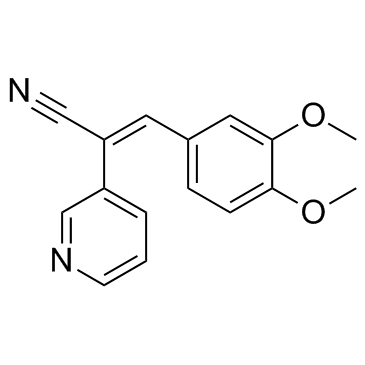RG-13022

RG-13022 structure
|
Common Name | RG-13022 | ||
|---|---|---|---|---|
| CAS Number | 136831-48-6 | Molecular Weight | 266.29500 | |
| Density | 1.172g/cm3 | Boiling Point | 423.8ºC at 760mmHg | |
| Molecular Formula | C16H14N2O2 | Melting Point | 118 °C | |
| MSDS | Chinese USA | Flash Point | 210.1ºC | |
|
The antiproliferative effects of tyrosine kinase inhibitors tyrphostins on a human squamous cell carcinoma in vitro and in nude mice.
Cancer Res. 51 , 4430, (1991) Many human tumors of epithelial origin contain cells overexpressing the epidermal growth factor (EGF) receptor, and there is convincing evidence that cancer cell growth is correlated with the loss of the normal regulation of the EGF receptor signal transducti... |
|
|
Intrapituitary regulatory system of mammotrophs in the mouse.
Arch. Physiol. Biochem. 110(1-2) , 34-41, (2002) Estrogen stimulates the proliferation of pituitary cells, in particular mammotrophs. The present study was designed to clarify involvement of transforming growth factor alpha (TGF-alpha) in the estrogen-induced growth of mouse pituitary cells in vitro. Anteri... |
|
|
Inhibition of breast cancer cell growth in vitro by a tyrosine kinase inhibitor.
Cancer Res. 52(13) , 3636-41, (1992) Human breast cancer cell proliferation is regulated by growth factors that bind to receptors with intrinsic tyrosine kinase (TK) activity, including the epidermal growth factor (EGF) receptor. To determine whether inhibition of receptor TK activity inhibits t... |
|
|
Epidermal growth factor-induced apoptosis in A431 cells can be reversed by reducing the tyrosine kinase activity.
Cell Growth Differ. 7(2) , 173-8, (1996) A431 cells overexpress epidermal growth factor receptors (EGF-Rs) and are inhibited by EGF. We show that treatment of A431 cells with 10 nM EGF induced a 15-fold increase in EGF-R autophosphorylation, leading to inhibition of cell proliferation and morphologi... |
|
|
Activation of the epidermal growth factor receptor by skin tumor promoters and in skin tumors from SENCAR mice.
Cell Growth Differ. 6(11) , 1447-55, (1995) The present study was designed to further investigate the role of the epidermal growth factor receptor (EGFr) in mouse skin tumor promotion by evaluating the status of the EGFr in tumor promoter-treated mouse epidermis and in mouse skin tumors. Female SENCAR ... |
|
|
Tyrosine kinase inhibitor as a novel signal transduction and antiproliferative agent: prostate cancer.
Mol. Cell. Endocrinol. 117(1) , 53-8, (1996) In prostate cancer cells, the binding of peptide growth factors to specific receptors increases tyrosine kinases (TK) activity to regulate cell proliferation, cell differentiation, and signaling processes. To determine whether inhibition of receptor TK activi... |
|
|
In vivo pharmacology and anti-tumour evaluation of the tyrphostin tyrosine kinase inhibitor RG13022.
Br. J. Cancer 74(11) , 1714-8, (1996) Amplification and increased expression of many growth factor receptors, including the epidermal growth factor receptor (EGFR), has been observed in human tumours. One therapeutic strategy for overcoming EGF autocrine control of tumour growth is inhibition of ... |
|
|
Transforming growth factor-alpha stimulates proliferation of mammotrophs and corticotrophs in the mouse pituitary.
J. Endocrinol. 165(2) , 493-501, (2000) Oestrogen stimulates the proliferation of pituitary cells. The present study was designed to clarify the involvement of transforming growth factor-alpha (TGF-alpha) in the oestrogen-induced growth of mouse pituitary cells in vitro. Anterior pituitary cells ob... |
|
|
Photoinstability of some tyrphostin drugs: chemical consequences of crystallinity.
Pharm. Res. 12(11) , 1708-15, (1995) The purpose of this work was to study the photostability of the antiproliferative tyrphostin drug compounds RG 13022(I) and RG 14620(II) as a part of preformulation program.The compounds were exposed to cool white fluorescent light in solution as well as in t... |